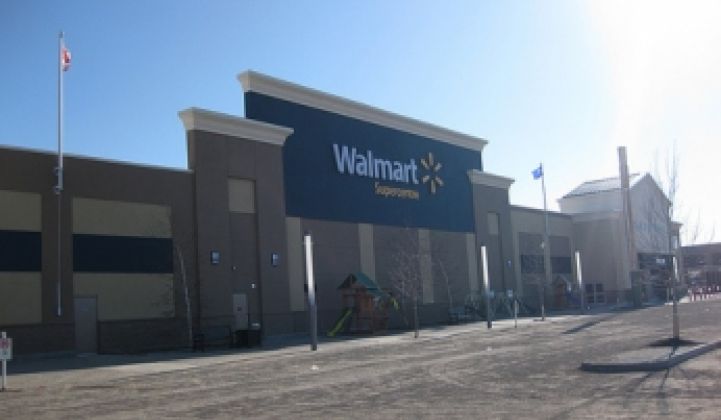The recent announcement by Walmart of the Sustainability Index firmly defines a common approach and supplier evaluation process for measuring sustainability in a supply chain. While numerous approaches are emerging for measuring and evaluating the sustainability maturity of a supply chain, Walmart's scale ensures this approach will be widely used and could become the de facto standard over time and a model for other industries and companies. The multi-step program begins with suppliers responding to 15 questions and reporting greenhouse gas (GHG) emissions to the Carbon Disclosure Project (CDP), a non-profit registry of company carbon footprints and sustainability efforts.
Walmart's involvement is a milestone event and moves sustainability from a marketing and compliance effort to a business imperative.
What Exactly Is Being Measured?
The Walmart program involves three steps. Step one is a Supplier Assessment involving 15 questions and is the focus on this article. Step two is an effort working with universities and experts to product a global database of carbon information at the product level. This will take a number of years to refine. Step three is a product label for product so consumers can make informed choices and consume in a sustainable way and is the eventual goal of the program.
The initial set of 15 questions for suppliers comprise questions about energy, GHG reduction and waste reduction, sourcing and social outreach. Questions include:
- Have you measured your corporate GHG emissions?
- What are your total GHG emissions?
- Do you know the locations of 100 percent of the facilities that product your products?
- Do you work with your supply base to resolve issues found during social compliance evaluations and also document specific corrections and improvements?
A list of all 15 questions is available on Walmart.com. Each question is weighted and graded, and the supplier receives an overall score.
Walmart has encouraged all of its 60,000 suppliers to complete the assessment, but has mandated that a subset of its suppliers report by October 1. It is anticipated that more suppliers will be required to participate next year, and this program will likely follow Walmart's Packaging scorecard program.
Walmart has requested suppliers to report to the CDP, an implicit endorsement of the CDP. Question two is "Have you opted to report your greenhouse gas emissions to the Carbon Disclosure Project (CDP)?" With 77 percent of the Global 500 voluntarily reporting to the CDP, the CDP is the global standard for large companies to publicly report their GHG emissions. Participation rates have been steadily rising and large firms now correctly look like laggards if they are not reporting to the CDP. The CDP Supply Chain Project is a new program where CDP-reporting large companies send a survey to their top suppliers with questions on GHG emissions and sustainability efforts.
Benefits of Supplier Assessments: Gauging Supply Chain Maturity and Competitive Differentiation
Supplier assessment programs offer a number of business benefits. One, suppliers become more aware of the benefits of sustainability when pressured to calculate their GHG emissions and articulate their sustainability plans. For many companies, requests from top customers like Walmart are the final catalyst to fund projects to calculate GHG emissions. An inventory of GHG emissions inevitably identifies cost savings opportunities and triggers new thinking about process. Two, supplier assessments assist companies in ascertaining the maturity of their supply chain by establishing a framework that asks questions about risk, cost, and flexibility. Third, supplier assessments help firms differentiate themselves in RFPs (many companies are adding sustainability questions to RFPs) and with existing customers who are demanding more sustainability capabilities. Lastly, organizational brand image is enhanced with stakeholders, particularly investors and environmental non-profits. Organizations like Environmental Defense Fund, Ceres, TruCost and others understand the value of transparency in supply chain and are increasingly adding this as evaluation criteria for company rating programs.
What Does This Mean for Suppliers to Walmart?
Viewing operations and products from a sustainability perspective offers opportunities to find new cost savings and to identify ways for competitive differentiation. Suppliers need to familiarize themselves with the 15 questions and use these questions to prioritize investments and programs for this year and next. Questions abound: what constitute an adequate response? What should are reduction goals be? What are adequate goals (5 percent reduction in three years, five years? What are others benchmarks and best practices? If completed done already, the first step for suppliers is to complete a GHG inventory or carbon footprint of their operations, as this is the natural starting point and often the most data intensive project.
This trend for more transparency throughout the supply chain and investment in sustainability is just starting and will continue, despite what happens with federal regulation of GHG. Walmart has learned that sustainability investments reduce cost and increase differentiation. This common approach by Walmart and CDP is a very important step forward for consumer products and can be used across many industries and companies. Business leaders ignore this trend to their peril.
Mr. Baier is VP of Consulting, Groom Energy Solutions.
Image of a Walmart super store via mjb84 / Creative Commons
Join the one-day only Walmart Supplier Readiness Workshop on Sept. 16 in Boston. Plus, learn how to differentiate your company with greener product lines at Greening the Supply Chain on Sept. 17 in Boston.




